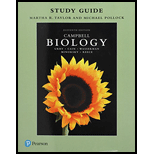
Study Guide for Campbell Biology
11th Edition
ISBN: 9780134443775
Author: Lisa A. Urry, Michael L. Cain, Steven A. Wasserman, Peter V. Minorsky, Jane B. Reece, Martha R. Taylor, Michael A. Pollock
Publisher: PEARSON
expand_more
expand_more
format_list_bulleted
Concept explainers
Question
Chapter 6, Problem 21TYK
Summary Introduction
Introduction: Lysosomes are membrane-bound organelles found in almost all animals and contain hydrolytic enzymes that are used to digest foods and other substances.
Expert Solution & Answer
Want to see the full answer?
Check out a sample textbook solution
Students have asked these similar questions
What is the structure and function of Eukaryotic cells, including their organelles? How are Eukaryotic cells different than Prokaryotic cells, in terms of evolution which form of the cell might have came first? How do Eukaryotic cells become malignant (cancerous)?
What are the roles of DNA and proteins inside of the cell? What are the building blocks or molecular components of the DNA and proteins? How are proteins produced within the cell? What connection is there between DNA, proteins, and the cell cycle? What is the relationship between DNA, proteins, and Cancer?
Why cells go through various types of cell division and how eukaryotic cells control cell growth through the cell cycle control system?
Chapter 6 Solutions
Study Guide for Campbell Biology
Ch. 6 - Prob. 1IQCh. 6 - a. Describe the molecular structure of the plasma...Ch. 6 - How does DNA in the nucleus direct protein...Ch. 6 - Name the components of the endomembrane system...Ch. 6 - Sketch a mitochondrion and a chloroplast and label...Ch. 6 - Why are peroxisomes not considered part of the...Ch. 6 - Fill in the following table to organize what you...Ch. 6 - Sketch two adjacent plant cells and show the...Ch. 6 - Label the indicated structures in this diagram of...Ch. 6 - Prob. 10IQ
Ch. 6 - In the following table, write the organelles or...Ch. 6 - Prob. 2SYKCh. 6 - Label the indicated structures in the following...Ch. 6 - Create a diagram or flowchart in the following...Ch. 6 - Prob. 1TYKCh. 6 - Prob. 2TYKCh. 6 - In an animal cell fractionation procedure, one of...Ch. 6 - You are a linear DNA molecule complexed with...Ch. 6 - The cells of an ant and an elephant are, on...Ch. 6 - Plasma cells are cells of the immune system...Ch. 6 - The pores in the nuclear envelope provide for the...Ch. 6 - A fluorescent green tag is attached to a protein...Ch. 6 - Although lysosomal enzymes are necessary for...Ch. 6 - Prob. 10TYKCh. 6 - Prob. 11TYKCh. 6 - Which of the following is a major component of the...Ch. 6 - Prob. 13TYKCh. 6 - Which of the following characteristics do the...Ch. 6 - Prob. 15TYKCh. 6 - Prob. 16TYKCh. 6 - Glycoproteins and lipoproteins are proteins...Ch. 6 - What would a cell use a desmosome for? a. food b....Ch. 6 - Which of the following is incorrectly paired with...Ch. 6 - In which cells would you expect to find the most...Ch. 6 - Prob. 21TYKCh. 6 - Prob. 22TYKCh. 6 - In which cells would you expect to find the most...
Knowledge Booster
Learn more about
Need a deep-dive on the concept behind this application? Look no further. Learn more about this topic, biology and related others by exploring similar questions and additional content below.Similar questions
- In one paragraph show how atoms and they're structure are related to the structure of dna and proteins. Talk about what atoms are. what they're made of, why chemical bonding is important to DNA?arrow_forwardWhat are the structure and properties of atoms and chemical bonds (especially how they relate to DNA and proteins).arrow_forwardThe Sentinel Cell: Nature’s Answer to Cancer?arrow_forward
- Molecular Biology Question You are working to characterize a novel protein in mice. Analysis shows that high levels of the primary transcript that codes for this protein are found in tissue from the brain, muscle, liver, and pancreas. However, an antibody that recognizes the C-terminal portion of the protein indicates that the protein is present in brain, muscle, and liver, but not in the pancreas. What is the most likely explanation for this result?arrow_forwardMolecular Biology Explain/discuss how “slow stop” and “quick/fast stop” mutants wereused to identify different protein involved in DNA replication in E. coli.arrow_forwardMolecular Biology Question A gene that codes for a protein was removed from a eukaryotic cell and inserted into a prokaryotic cell. Although the gene was successfully transcribed and translated, it produced a different protein than it produced in the eukaryotic cell. What is the most likely explanation?arrow_forward
- Molecular Biology LIST three characteristics of origins of replicationarrow_forwardMolecular Biology Question Please help. Thank you For E coli DNA polymerase III, give the structure and function of the b-clamp sub-complex. Describe how the structure of this sub-complex is important for it’s function.arrow_forwardMolecular Biology LIST three characteristics of DNA Polymerasesarrow_forward
arrow_back_ios
SEE MORE QUESTIONS
arrow_forward_ios
Recommended textbooks for you

 Concepts of BiologyBiologyISBN:9781938168116Author:Samantha Fowler, Rebecca Roush, James WisePublisher:OpenStax College
Concepts of BiologyBiologyISBN:9781938168116Author:Samantha Fowler, Rebecca Roush, James WisePublisher:OpenStax College






Concepts of Biology
Biology
ISBN:9781938168116
Author:Samantha Fowler, Rebecca Roush, James Wise
Publisher:OpenStax College